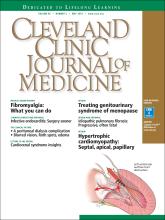Article Figures & Data
Tables
Feature Inflammatory pain Centralized pain Location Hands, wrists, cervical spine, knees, hips, ankles, feet More diffuse, “all over,” tender points Relationship to time of day Nocturnal, with rest, early morning Nocturnal, with rest, early morning Relationship to exertion Better with exertion Better during exertion, worse after Character of pain Constant, dull, achy Intermittent, stabbing, burning, “like being hit by a truck,” “unbearable” Duration Variable Often many years General associated symptoms and signs Fatigue, fever, other organ signs and symptoms Fatigue, weakness, headaches, irritable bowel syndrome symptoms, cognitive impairment, disturbed sleep, mood disorders, dry eyes and mouth, light sensitivity, difficulty swallowing, sensation of swollen glands in neck, urinary frequency, feeling faint after hot shower or in hot weather Localized associated symptoms and signs Stiffness ≥ 60 minutes
Objective swellingStiffness ≥ 60 minutes
Lack of objective findings
Tender points
Allodynia (pain from normally nonpainful stimuli), hyperalgesia (increased sensitivity to pain)
Acrocyanosis (bluish coloring of hands and feet)
Brisk reflexesLaboratory results Inflammatory picture: elevated C-reactive protein and Westergren sedimentation rate, anemia, occasionally elevated platelet count, positive serologies (rheumatoid factor, anti-cyclic citrullinated peptide, extractable nuclear antigen panel) Normal Associated with autoimmune disease Nuclear homogeneous Nuclear coarse-speckled Nuclear centromeric Associated with healthy individuals Nuclear dense fine-speckled Most common, found in both groups Nuclear fine-speckled Based on information in reference 9.
Domains Key questions and characteristics Tests Mood Ever diagnosed with depression, anxiety, or other psychiatric condition? Depression (PHQ-9)
Anxiety (GAD-7)
Bipolar screen (MDQ)Sleep Difficulty falling or staying asleep? Average hours slept, daytime sleepiness, snoring, apnea?
Prior diagnosis of narcolepsy, sleep apnea, or restless leg syndrome?Physical conditioning Moderate aerobic exercise at least 30 minutes 3 times a week? Stressful life events Past stressors: born premature, unhappy childhood, history of mental, physical, or sexual abuse?
Current stressors: financial, family, health, social?Maladaptive pain responses, catastrophizing Does patient use a lot of drama to describe symptoms? Pain Catastrophizing Scale Function Are you working? Have you applied for disability benefits? GAD-7 = Generalized Anxiety Disorder Assessment; MDQ = Mood Disorder Questionnaire; PHQ-9 = Patient Health Questionnaire-Depression 9






